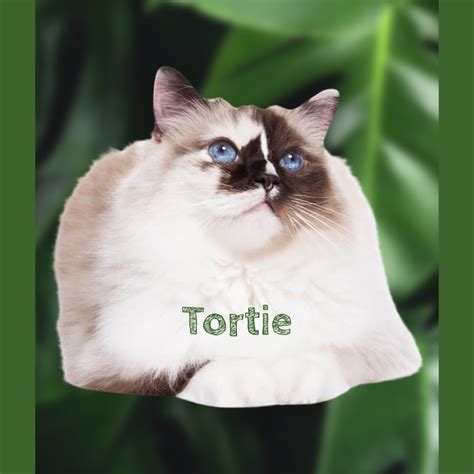
A Ragdoll cat with a rare tortoiseshell pattern, known as a “tortie,” has captivated the internet, with some enthusiasts even proclaiming its fur pattern as potentially the “8th Wonder” of the world due to its striking and unique coloration.
The feline, whose images have gone viral across social media platforms, showcases a distinctive blend of colors that exemplifies the tortoiseshell pattern, a genetic marvel primarily found in female cats. The unique combination of colors and the Ragdoll breed’s characteristic long, silky fur have made this particular cat a social media sensation, drawing attention from cat lovers worldwide and sparking conversations about feline genetics and beauty standards.
The captivating allure of this “tortie” Ragdoll stems from the genetic factors that govern coat color in cats. Tortoiseshell patterns arise from the interaction of two different versions (alleles) of a gene located on the X chromosome, which controls black and orange pigmentation. Because female cats have two X chromosomes (XX), they can carry both alleles, resulting in a mosaic-like pattern of black and orange (or their diluted versions, such as blue and cream). Male cats, with only one X chromosome (XY), typically display either black or orange coloration, but not both. The occurrence of a male tortoiseshell cat is extremely rare, requiring a specific chromosomal abnormality (XXY).
Ragdolls are known for their docile temperament, striking blue eyes, and semi-long, plush coats. Their combination with the tortoiseshell pattern creates a visually stunning and genetically intriguing feline. The tortie Ragdoll’s widespread attention highlights the public’s fascination with unique animal characteristics and the role of social media in amplifying niche interests.
“She’s truly one of a kind, and we feel so lucky to have her,” said one of the cat’s owners, according to various social media posts associated with images of the cat.
The cat’s popularity also raises questions about the increasing trend of online pet appreciation and the potential impact on breed popularity and responsible pet ownership. While the admiration for unique feline aesthetics is generally harmless, experts caution against breeding practices that prioritize appearance over health and temperament.
The online buzz surrounding this tortie Ragdoll serves as a reminder of the diversity and beauty within the animal kingdom and the power of social media to connect individuals through shared interests. The question remains whether its coat truly represents an “8th Wonder,” but there is no doubt that this feline has captured the hearts and minds of cat lovers around the world.
The Genetics Behind the Tortoiseshell Pattern
The tortoiseshell pattern, a striking mosaic of black and orange (or their diluted counterparts, blue and cream), is a fascinating example of X-linked inheritance in cats. The gene responsible for orange or black pigment is located on the X chromosome. Because female cats have two X chromosomes, they can express both alleles, resulting in the characteristic tortoiseshell or calico pattern (if white spotting is also present).
During early embryonic development in female cats, one of the two X chromosomes in each cell is randomly inactivated, a process called X-inactivation or Lyonization. This means that in some cells, the X chromosome carrying the gene for black pigment is active, while in other cells, the X chromosome carrying the gene for orange pigment is active. This random inactivation leads to the mosaic pattern of color distribution observed in tortoiseshell cats.
Male cats, possessing only one X chromosome, typically exhibit either black or orange pigmentation, not both. However, in rare cases, a male cat can inherit an extra X chromosome (XXY, a condition known as Klinefelter syndrome), allowing for the expression of both black and orange alleles and resulting in a male tortoiseshell or calico cat. These male tortoiseshells are almost always sterile.
The specific shades and distribution of colors in a tortoiseshell cat’s coat can vary widely, depending on the specific alleles present, the timing of X-inactivation during development, and the influence of other genes that affect coat color. Some tortoiseshell cats may have a fairly even distribution of black and orange, while others may have larger patches or streaks of one color or the other.
The presence of white spotting, caused by a separate gene, can modify the tortoiseshell pattern, resulting in a calico cat. Calico cats have large patches of white in addition to the black and orange (or blue and cream) coloration.
Ragdoll Breed Characteristics and Temperament
Ragdolls are a relatively modern breed of cat, developed in the 1960s by Ann Baker in Riverside, California. They are known for their large size, semi-long, silky coat, striking blue eyes, and docile, affectionate temperament.
Ragdolls are typically laid-back and gentle cats, known for their tendency to go limp when held, hence the name “Ragdoll.” They are often described as “dog-like” in their behavior, as they are typically very social and enjoy interacting with their human companions. They are also known for being relatively quiet and non-demanding cats.
Ragdolls have a distinctive coat that is soft, silky, and semi-long. Their coat is not prone to matting, making them relatively easy to groom. They come in a variety of colors and patterns, including pointed, mitted, bicolored, and solid.
The pointed pattern is the most common and recognizable Ragdoll pattern. Pointed Ragdolls have a light-colored body with darker coloration on their face, ears, paws, and tail. The mitted pattern is similar to the pointed pattern, but with white “mitts” on their front paws and white “boots” on their back paws. Bicolored Ragdolls have a white inverted “V” on their face and white legs. Solid Ragdolls are less common and have a uniform color throughout their coat.
Ragdolls are generally healthy cats, but they are prone to certain genetic health conditions, including hypertrophic cardiomyopathy (HCM), a type of heart disease, and polycystic kidney disease (PKD). Responsible breeders screen their cats for these conditions to minimize the risk of passing them on to their offspring.
Social Media and Pet Popularity
The internet and social media have profoundly impacted pet ownership and breed popularity. Social media platforms provide a venue for pet owners to share photos and videos of their animals, creating a sense of community and fostering appreciation for unique and rare breeds or coat patterns.
The viral spread of images and videos of animals like the tortie Ragdoll can significantly influence breed popularity. As more people are exposed to a particular breed or coat pattern, demand for that type of animal may increase.
However, this increased demand can also lead to irresponsible breeding practices. Some breeders may prioritize appearance over health and temperament in an attempt to capitalize on the popularity of a particular breed or coat pattern. This can result in the propagation of genetic health problems and undesirable behavioral traits.
It is essential for potential pet owners to research breeds thoroughly and choose a reputable breeder who prioritizes the health and well-being of their animals. Responsible breeders will screen their cats for genetic health conditions and will be transparent about the health and temperament of their cats.
The internet can also be a valuable resource for finding information about responsible pet ownership. There are many websites and online communities dedicated to providing information about cat care, training, and health.
The Ethics of Breeding for Appearance
The breeding of animals for specific physical traits raises ethical considerations. While selective breeding has been practiced for centuries, the increasing emphasis on appearance over health and temperament in some breeds has raised concerns among animal welfare advocates.
Breeding for extreme physical traits can lead to a variety of health problems. For example, brachycephalic (short-nosed) dog breeds, such as pugs and bulldogs, are prone to breathing difficulties, eye problems, and skin infections due to their exaggerated facial features.
Similarly, breeding cats for specific coat colors or patterns can sometimes be associated with genetic health problems. For example, white cats with blue eyes are more likely to be deaf.
Animal welfare advocates argue that breeders have a responsibility to prioritize the health and well-being of their animals over aesthetic considerations. They advocate for breeding practices that promote genetic diversity and minimize the risk of genetic health problems.
Responsible Pet Ownership
Responsible pet ownership is essential for ensuring the health and well-being of animals. Responsible pet owners provide their pets with proper nutrition, veterinary care, exercise, and socialization.
Responsible pet owners also understand the specific needs of their chosen breed or species. They research the breed’s temperament, exercise requirements, and potential health problems.
Responsible pet ownership also includes spaying or neutering pets to prevent unwanted litters. Overpopulation of pets is a serious problem, leading to euthanasia of millions of animals each year.
The Allure of Unique Animal Characteristics
The human fascination with unique animal characteristics is deeply rooted in our curiosity about the natural world. We are drawn to animals that exhibit unusual colors, patterns, or behaviors.
This fascination may stem from our desire to understand the genetic and environmental factors that contribute to these unique characteristics. It may also be a reflection of our aesthetic appreciation for beauty and diversity.
The popularity of animals like the tortie Ragdoll demonstrates the power of social media to connect individuals through shared interests and to amplify appreciation for the diversity and beauty within the animal kingdom.
FAQ about the Tortie Ragdoll
-
What is a “tortie” cat?
A “tortie” or tortoiseshell cat is a feline with a coat that displays a mosaic pattern of black and orange (or their diluted versions, blue and cream). This pattern is primarily found in female cats due to the genetic factors related to the X chromosome. The coloration comes from X-inactivation where different X chromosomes express different colors during development, leading to the mosaic look.
-
Why are tortoiseshell cats usually female?
The genes that determine black and orange coat color are located on the X chromosome. Female cats have two X chromosomes (XX), allowing them to carry both the gene for black and the gene for orange. During early development, one X chromosome in each cell is randomly inactivated (X-inactivation), resulting in some cells expressing the black gene and others expressing the orange gene, creating the tortoiseshell pattern. Male cats have one X and one Y chromosome (XY) and typically express either black or orange, but not both, unless they have a rare chromosomal abnormality (XXY).
-
What makes this tortie Ragdoll cat so special?
The combination of the tortoiseshell pattern with the Ragdoll breed’s characteristics makes this cat particularly striking. Ragdolls are known for their large size, semi-long, silky fur, blue eyes, and docile temperament. The unique and relatively rare tortoiseshell coloration, combined with the Ragdoll’s already appealing traits, has made this particular cat a social media sensation.
-
Are there any health concerns associated with tortoiseshell cats or Ragdolls?
Tortoiseshell coloration itself is not associated with any specific health concerns. However, Ragdolls are prone to certain genetic health conditions, including hypertrophic cardiomyopathy (HCM), a type of heart disease, and polycystic kidney disease (PKD). Reputable breeders screen their cats for these conditions to minimize the risk of passing them on to their offspring. Potential owners should always inquire about the breeder’s health screening practices.
-
How can I find a reputable breeder if I want to get a Ragdoll cat?
Finding a reputable breeder is crucial to ensuring the health and well-being of your cat. Look for breeders who are transparent about their breeding practices, health screening, and the temperament of their cats. Reputable breeders will typically be registered with recognized breed organizations (e.g., The Cat Fanciers’ Association, TICA), allow you to visit their cattery, and be willing to answer your questions honestly. Avoid breeders who prioritize profit over the health and welfare of their animals. You can also consult with local cat clubs and veterinarians for referrals to reputable breeders.
Expanded Context and Analysis
The case of the viral tortie Ragdoll exemplifies several interconnected trends and issues within the world of pet ownership, social media, and animal breeding. The cat’s widespread popularity is not merely a fleeting internet phenomenon; it is symptomatic of a deeper cultural fascination with unique animal aesthetics, the power of online platforms to amplify niche interests, and the potential pitfalls of prioritizing appearance over welfare in animal breeding.
The “8th Wonder” moniker, while hyperbolic, underscores the intense emotional connection that many people form with their pets and the increasing tendency to project human emotions and values onto animals. This anthropomorphism, while often harmless, can sometimes lead to unrealistic expectations and potentially detrimental breeding practices.
The Ragdoll breed itself has experienced a surge in popularity in recent years, driven in part by their docile temperament and striking appearance. Their gentle nature and tolerance for handling make them ideal companions for families with children, while their plush coats and captivating blue eyes contribute to their aesthetic appeal. However, this popularity has also attracted unscrupulous breeders who prioritize profit over health, leading to an increased risk of genetic health problems within the breed.
The tortoiseshell pattern, with its intricate mosaic of colors, adds another layer of complexity to the cat’s appeal. The genetic basis of this pattern, involving X-inactivation and the interaction of different alleles, is a fascinating example of biological diversity. The fact that tortoiseshell cats are almost exclusively female further contributes to their mystique and perceived rarity.
The viral spread of the tortie Ragdoll’s image highlights the power of social media to shape perceptions of beauty and desirability. The algorithms that govern these platforms often amplify content that elicits strong emotional responses, leading to a phenomenon known as “viral contagion.” In this case, the cat’s unique appearance triggered a wave of shares, likes, and comments, further fueling its popularity and visibility.
However, the online buzz surrounding the cat also raises concerns about the potential for irresponsible breeding practices. As demand for similar-looking cats increases, some breeders may be tempted to prioritize appearance over health and temperament, leading to the propagation of genetic health problems and undesirable behavioral traits.
Animal welfare advocates have long cautioned against breeding practices that focus solely on aesthetics, arguing that the health and well-being of animals should always be the primary consideration. They advocate for breeding programs that promote genetic diversity, screen for inherited diseases, and prioritize temperament.
Responsible pet ownership also plays a crucial role in mitigating the risks associated with breeding for appearance. Potential pet owners should thoroughly research breeds before acquiring an animal, choosing a reputable breeder who prioritizes health and temperament. They should also be prepared to provide their pets with proper nutrition, veterinary care, exercise, and socialization.
The case of the tortie Ragdoll serves as a reminder that the human-animal bond is complex and multifaceted. While there is nothing inherently wrong with appreciating the aesthetic beauty of animals, it is essential to ensure that our admiration does not come at the expense of their health and well-being. The key lies in balancing our desire for aesthetically pleasing pets with a commitment to responsible breeding practices and ethical pet ownership. The question of whether the cat’s fur represents an “8th Wonder” may be a matter of opinion, but the ethical considerations surrounding its popularity are undeniably important.









